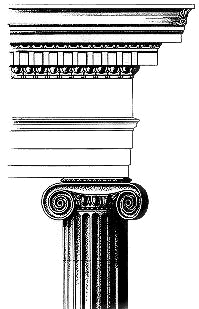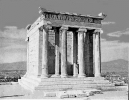The Ionic Order |
The Ionic Order |
 Whereas the Doric order was developed on the mainland and in Greek colonies, the Ionic order was used on the Greek islands and in Asia Minor. The general structure is similar to the Doric order with these differences:
Whereas the Doric order was developed on the mainland and in Greek colonies, the Ionic order was used on the Greek islands and in Asia Minor. The general structure is similar to the Doric order with these differences: instead of an entablature consisting of triglyphs and metopes, it has a continuous frieze which was often decorated with sculpture; the column rests on a base and is topped with an Ionic capital. This kind of capital has two different front and side views (and is best seen from the front or back). The ornamental scrolls of the capital are called volutes.
instead of an entablature consisting of triglyphs and metopes, it has a continuous frieze which was often decorated with sculpture; the column rests on a base and is topped with an Ionic capital. This kind of capital has two different front and side views (and is best seen from the front or back). The ornamental scrolls of the capital are called volutes.
 Kallikrates, Temple of Athena Nike, Acropolis, Athens, about 427-424 BCE: Although small, the Temple dedicated to Athena Nike (Athena of Victory) is a well-preserved example of the Ionic order. It commemorates the victory of the Athenians over the Persians in 469 BCE. Not only does its name signify this victory but part of the continuous frieze represents the decisive battle at Marathon. This is not typical, however, for sculptural decoration is usually mythical rather than historical.
Kallikrates, Temple of Athena Nike, Acropolis, Athens, about 427-424 BCE: Although small, the Temple dedicated to Athena Nike (Athena of Victory) is a well-preserved example of the Ionic order. It commemorates the victory of the Athenians over the Persians in 469 BCE. Not only does its name signify this victory but part of the continuous frieze represents the decisive battle at Marathon. This is not typical, however, for sculptural decoration is usually mythical rather than historical.
All images marked MAS were photographed on location by Mary Ann Sullivan. All other images were scanned from other sources or downloaded from the World Wide Web; they are posted on this password-protected site for educational purposes, at Bluffton College only, under the "fair use" clause of U.S. copyright law.